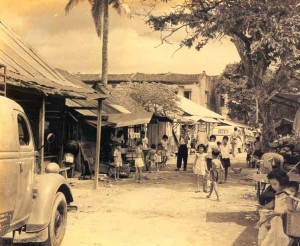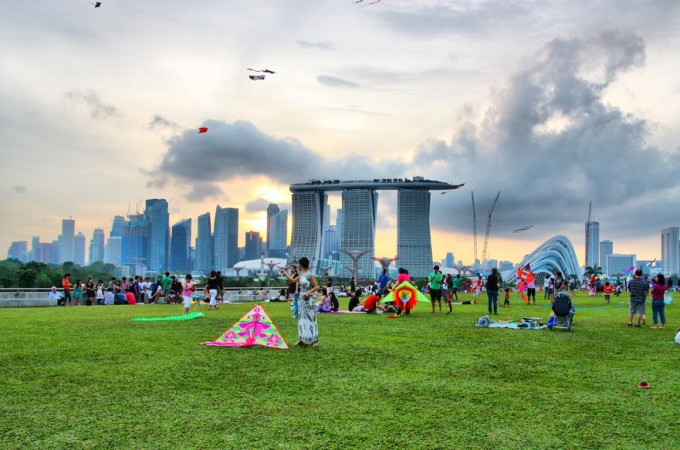Singapore, identified by its people as the “Garden City,” is one of the most beautiful cities in the world.
It has not always been so.
 On August 9, 1965, when Singapore gained independence from Malaysia, it was a dirty, crime-infested, corruption-ridden, poor, crowded, inhospitable, resource-deprived third-world nation, perched on a 286-square-mile island, about 60% the area of New York City.
On August 9, 1965, when Singapore gained independence from Malaysia, it was a dirty, crime-infested, corruption-ridden, poor, crowded, inhospitable, resource-deprived third-world nation, perched on a 286-square-mile island, about 60% the area of New York City.
Today, just over 50 years later, Singapore is one of the most beautiful, clean, sustainable, and prosperous states in the world, with the third highest per capita GDP.
Less than two years after the nation’s birth, and a month before Singapore issued its first currency (June 12, 1967), Prime Minister Lee Kuan Yew (also known as “Chief Gardener”) cast his vision: Singapore would become “a garden city with flowers and trees, and as tidy and litterless as can be….” He resolved
… to transform Singapore into a city with abundant lush greenery and a clean environment in order to make life more pleasant for the people. It was also envisaged that the presence of ample greenery in an environment clean of litter would signify that Singapore was a well-organized city and hence a good destination for tourists and foreign investments.
In more recent years, the Urban Redevelopment Authority was established and chartered with the responsibility to continue Lee’s vision. Its mission is “to make Singapore a great city to live, work and play.”
The “people centered” development plan was established and revised by three stakeholder groups: community leaders, business leaders and government. Dario Hidalgo reports that this plan:
… includes developing the city in a way that provides connections with others, opportunities for social interaction, access to numerous services, and an inclusive environment. These elements in the current plan (2013) translate to such concrete developments as building affordable homes, creating green spaces, enhancing mobility and transport connectivity, sustaining the vibrant economy with good jobs, and dedicating resources to the preservation of the environment.
 The goal of the master plan is to maintain a ratio of at least one acre of green space for each acre of developed land. Strong progress toward this goal is reflected in the myriad of parks and parkways, walkways and bike paths, and large tracts of land still forested despite the rapid development of the city.
The goal of the master plan is to maintain a ratio of at least one acre of green space for each acre of developed land. Strong progress toward this goal is reflected in the myriad of parks and parkways, walkways and bike paths, and large tracts of land still forested despite the rapid development of the city.
A recent monograph, Designing Our City: Planning for A Sustainable Singapore, gives further insight into the current situation facing the modern Singapore.
While our challenges today are vastly different from the 1960s, our priority remains the same: catering for economic growth and a good quality of life, maintaining a clean and green environment, and making the best use of our resources. What has constantly guided our approach to sustainable development is far-sighted, holistic, and comprehensive planning, which enables us to take into account future development needs through an integrated planning process. Our objectives are:
Economic: Sustain a robust and vibrant economy
Social: Provide a good quality of living and a sense of well-being for all
Environmental: Develop in an environmentally responsible manner
Land and sea: Optimise our limited land and sea space
Singapore wants to become a city in a garden
Hidalgo writes of the outcome of this vision of a garden city with its broad-based, comprehensive, intentional Strategic Development Plan:
Singapore is now ranked number three in GDP per Capita with 60,799 and number 18 in the UN Human Development Index. The country is considered the safest in the world, with 0.3 homicides per 100,000 people. In comparison, the United States had 4.3 homicides per 100,000 people in 2011. Singapore also ranks highly in road safety, with 4.46 fatalities per 100,000 people in 2010, a figure lower than Sweden (5.52).
For more see: Urbanism Hall of Fame: Lee Kwan Yew shaped Singapore as the “Garden City”.
 With its garden-city goal in view, Singapore now has its sights on becoming a city in a garden.
With its garden-city goal in view, Singapore now has its sights on becoming a city in a garden.
The CEO of Singapore’s National Parks Board, Poon Hong Yeun, explains the difference: “It’s a bit like saying my house has a garden and my house is in the middle of a garden. What it means is having pervasive greenery, as well as biodiversity, including wildlife, all around you.” For more on this see “Singapore aims to become a city in a garden.”
Prime Minister Lee has been regarded by some Western observers as a “benevolent dictator,” and he did lead with a strong hand. Yet he maintained a remarkable humility, living simply (in the same house with the same furniture for 40 years) and relating “humbly” to his household staff. He was known for his utter refusal to be corrupted. Lee was a visionary leader who served his people selflessly. The fact that Singapore moved from one of the poorest countries in Asia to one of the most safe, clean and prosperous countries in the world is both a tribute to Lee’s leadership and a model of hope for impoverished nations today.
I am fascinated by the history and unfolding of this vision for a garden city. Singapore is unique in this regard, as far as I know. Yet it is a kingdom vision. After all, the consuming vision of the Bible is the coming City of God, the New Jerusalem, also presented as a garden city (or perhaps a city within a garden).
For many years, I have understood that the Telos, the consummation of history, is the City of God (Hebrews 11:8-10), the New Jerusalem (Rev. 21:1-2) which is also a Garden-City (Rev. 22:1-3):
Then the angel showed me the river of the water of life, as clear as crystal, flowing from the throne of God and of the Lamb down the middle of the great street of the city. On each side of the river stood the tree of life, bearing twelve crops of fruit, yielding its fruit every month. And the leaves of the tree are for the healing of the nations. No longer will there be any curse. The throne of God and of the Lamb will be in the city, and his servants will serve him.
Our story begins in Genesis and ends in Revelation. It begins in a Garden and ends in a Garden-City.
Genesis 2:10 speaks of a river watering the Garden of Eden. But the garden is not to be left “natural.” Genesis 2:15 states that the man (and his coming family) is to “work it and take care of it.” This is part of the Cultural Commission given to humans to take what God has created and do something with it. This requires both work – to progress, and care – to conserve.
The garden represents conserving, the place of nature, beauty, the land, health, open skies and open spaces. The city represents progressing, the place of people  gathering, the place of commerce, of creating, of new ideas and new worlds, of art, symphony, and science/technology.
gathering, the place of commerce, of creating, of new ideas and new worlds, of art, symphony, and science/technology.
The cultural commission transforms the Garden into a garden city. This stands in stark contrast to the raping of the earth for human consumption that creates cities without gardens, the destitute, sterile, dead environment of many of the world’s cities today. Materialists often want “progress” without conserving.
This vision also contrasts to the radical “green” vision of an earth without human beings. The “greens” often want to conserve without progressing. I recently read the slogan, “Humans are a cancer to the world. True environmentalists are the people who remove themselves from earth.”
The Garden City at the end of history is the ultimate goal of the Cultural Commission, given to human beings to working and to carry, for progressing and conserving. Perhaps the image of Singapore as the Garden City can be a human model of a kingdom reality.
- Darrow Miller







4 Comments
Stuart Simpson
March 17, 2016 - 9:22 amYes, Singapore is a wonderful example of a garden city on a national scale, although I wouldn’t go as far as equating it with the New Jerusalem, as this is a picture of the Church, the eternal dwelling place of God, not a city built by human hands.
admin
March 17, 2016 - 12:12 pmHi Stuart
Thanks for your comments. Yes, Singapore is an example of a garden city. But in response to your concern we could explain it somewhat differently, the Singapore is a mere shadow of the glorious city to come. Certainly we would not make Singapore “equal” with the New Jerusalem; but we can say, that in the sense that Singapore has captured the vision of a garden-city and it is “like” the New Jerusalem in a way that most sterile cities – void of gardens, are not.
Yes the New Jerusalem is the eternal dwelling place of God, and it is his “dwelling place with man” (Rev. 21:3). We will dwell with God for eternity in this city.
And perhaps we can say that the City of God is adorned by artifacts created by human hands, the fruit of the Cultural Commission of Genesis 1. I think this is the indication of Revelation 21: 23-26.
Stuart, thanks again for your comments.
Stuart Simpson
March 17, 2016 - 1:00 pmThanks for your response. To clarify, I was just trying to caution the idea that we will spend eternity in some kind of ‘celestial city’ as city-dwellers (I’m sure many would prefer Paradise to be more like the original Garden of Eden!). I believe the Scriptures point to the New Jerusalem being God’s people, the bride of Christ, “living stones”, not an actual city that will appear like some UFO coming down from the sky.
admin
March 19, 2016 - 6:26 amThank you, Stuart. At the end of time, we will discover the reality of the glorious vision.
darrow